power steering NISSAN KICKS 2019 Owner´s Manual
[x] Cancel search | Manufacturer: NISSAN, Model Year: 2019, Model line: KICKS, Model: NISSAN KICKS 2019Pages: 444, PDF Size: 5.55 MB
Page 322 of 444
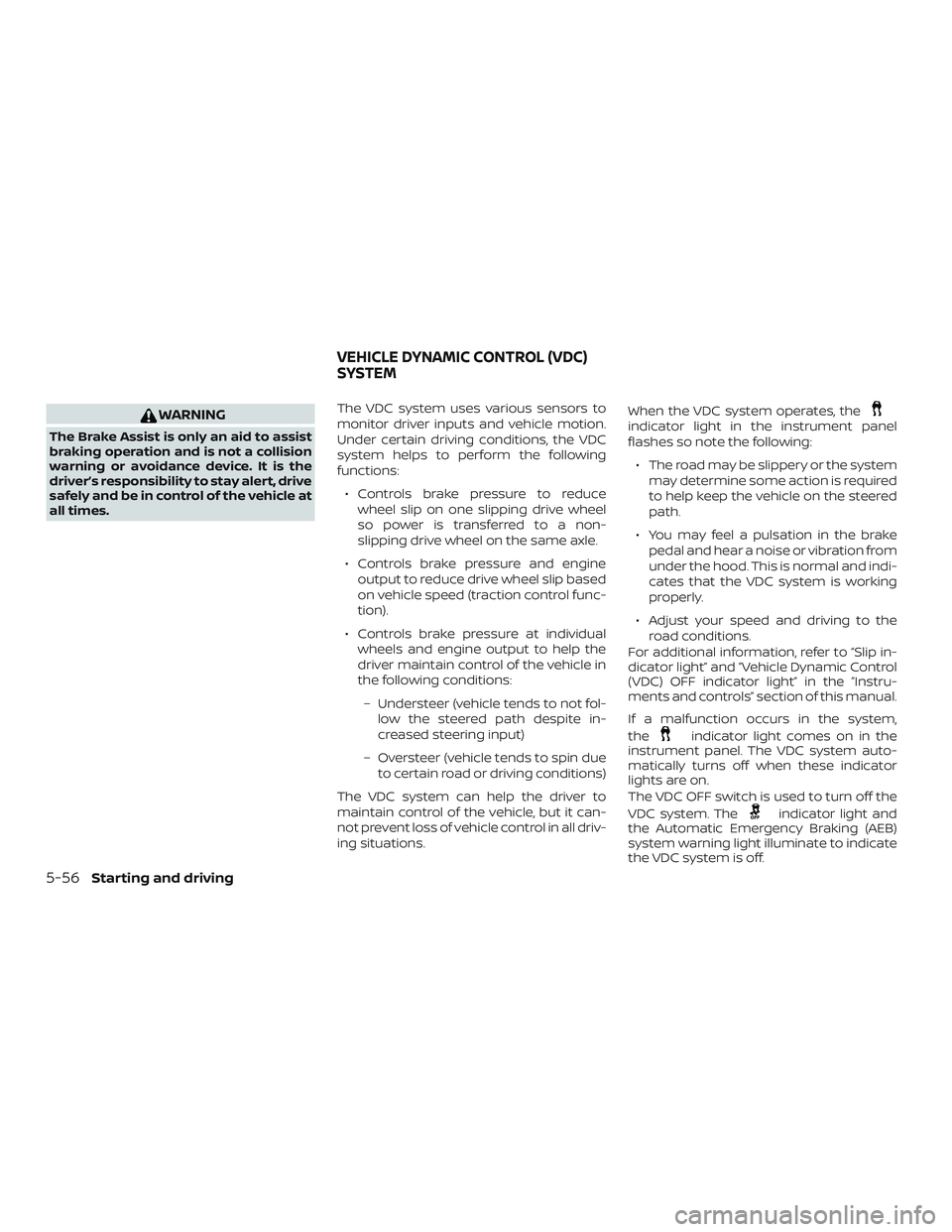
WARNING
The Brake Assist is only an aid to assist
braking operation and is not a collision
warning or avoidance device. It is the
driver’s responsibility to stay alert, drive
safely and be in control of the vehicle at
all times.The VDC system uses various sensors to
monitor driver inputs and vehicle motion.
Under certain driving conditions, the VDC
system helps to perform the following
functions:
∙ Controls brake pressure to reduce wheel slip on one slipping drive wheel
so power is transferred to a non-
slipping drive wheel on the same axle.
∙ Controls brake pressure and engine output to reduce drive wheel slip based
on vehicle speed (traction control func-
tion).
∙ Controls brake pressure at individual wheels and engine output to help the
driver maintain control of the vehicle in
the following conditions:
– Understeer (vehicle tends to not fol- low the steered path despite in-
creased steering input)
– Oversteer (vehicle tends to spin due to certain road or driving conditions)
The VDC system can help the driver to
maintain control of the vehicle, but it can-
not prevent loss of vehicle control in all driv-
ing situations. When the VDC system operates, theindicator light in the instrument panel
flashes so note the following:
∙ The road may be slippery or the system may determine some action is required
to help keep the vehicle on the steered
path.
∙ You may feel a pulsation in the brake pedal and hear a noise or vibration from
under the hood. This is normal and indi-
cates that the VDC system is working
properly.
∙ Adjust your speed and driving to the road conditions.
For additional information, refer to “Slip in-
dicator light” and ”Vehicle Dynamic Control
(VDC) OFF indicator light” in the ”Instru-
ments and controls” section of this manual.
If a malfunction occurs in the system,
the
indicator light comes on in the
instrument panel. The VDC system auto-
matically turns off when these indicator
lights are on.
The VDC OFF switch is used to turn off the
VDC system. The
indicator light and
the Automatic Emergency Braking (AEB)
system warning light illuminate to indicate
the VDC system is off.
VEHICLE DYNAMIC CONTROL (VDC)
SYSTEM
5-56Starting and driving
Page 323 of 444
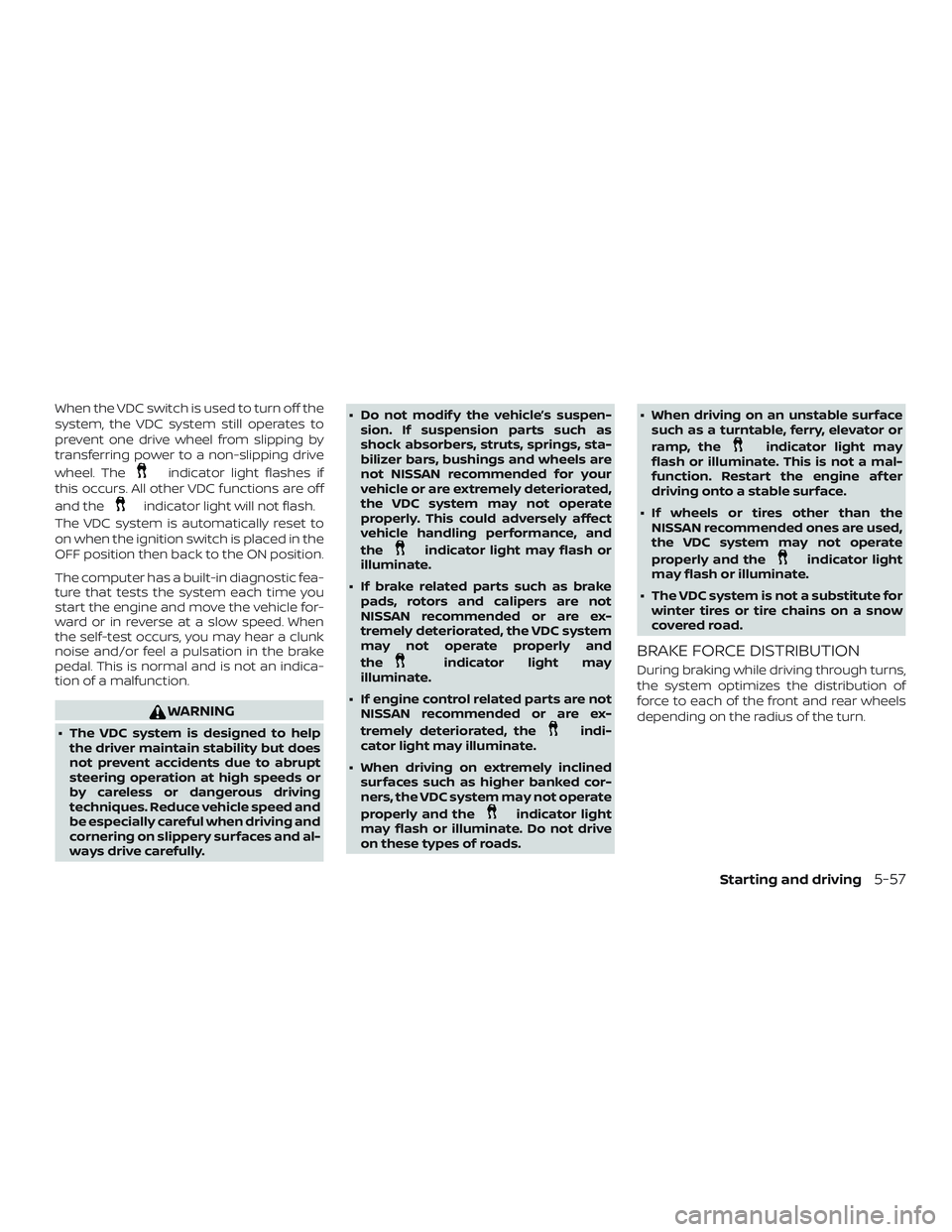
When the VDC switch is used to turn off the
system, the VDC system still operates to
prevent one drive wheel from slipping by
transferring power to a non-slipping drive
wheel. The
indicator light flashes if
this occurs. All other VDC functions are off
and the
indicator light will not flash.
The VDC system is automatically reset to
on when the ignition switch is placed in the
OFF position then back to the ON position.
The computer has a built-in diagnostic fea-
ture that tests the system each time you
start the engine and move the vehicle for-
ward or in reverse at a slow speed. When
the self-test occurs, you may hear a clunk
noise and/or feel a pulsation in the brake
pedal. This is normal and is not an indica-
tion of a malfunction.
WARNING
∙ The VDC system is designed to help the driver maintain stability but does
not prevent accidents due to abrupt
steering operation at high speeds or
by careless or dangerous driving
techniques. Reduce vehicle speed and
be especially careful when driving and
cornering on slippery surfaces and al-
ways drive carefully. ∙ Do not modif y the vehicle’s suspen-
sion. If suspension parts such as
shock absorbers, struts, springs, sta-
bilizer bars, bushings and wheels are
not NISSAN recommended for your
vehicle or are extremely deteriorated,
the VDC system may not operate
properly. This could adversely affect
vehicle handling performance, and
the
indicator light may flash or
illuminate.
∙ If brake related parts such as brake pads, rotors and calipers are not
NISSAN recommended or are ex-
tremely deteriorated, the VDC system
may not operate properly and
the
indicator light may
illuminate.
∙ If engine control related parts are not NISSAN recommended or are ex-
tremely deteriorated, the
indi-
cator light may illuminate.
∙ When driving on extremely inclined surfaces such as higher banked cor-
ners, the VDC system may not operate
properly and the
indicator light
may flash or illuminate. Do not drive
on these types of roads. ∙ When driving on an unstable surface
such as a turntable, ferry, elevator or
ramp, the
indicator light may
flash or illuminate. This is not a mal-
function. Restart the engine af ter
driving onto a stable surface.
∙ If wheels or tires other than the NISSAN recommended ones are used,
the VDC system may not operate
properly and the
indicator light
may flash or illuminate.
∙ The VDC system is not a substitute for winter tires or tire chains on a snow
covered road.
BRAKE FORCE DISTRIBUTION
During braking while driving through turns,
the system optimizes the distribution of
force to each of the front and rear wheels
depending on the radius of the turn.
Starting and driving5-57
Page 341 of 444
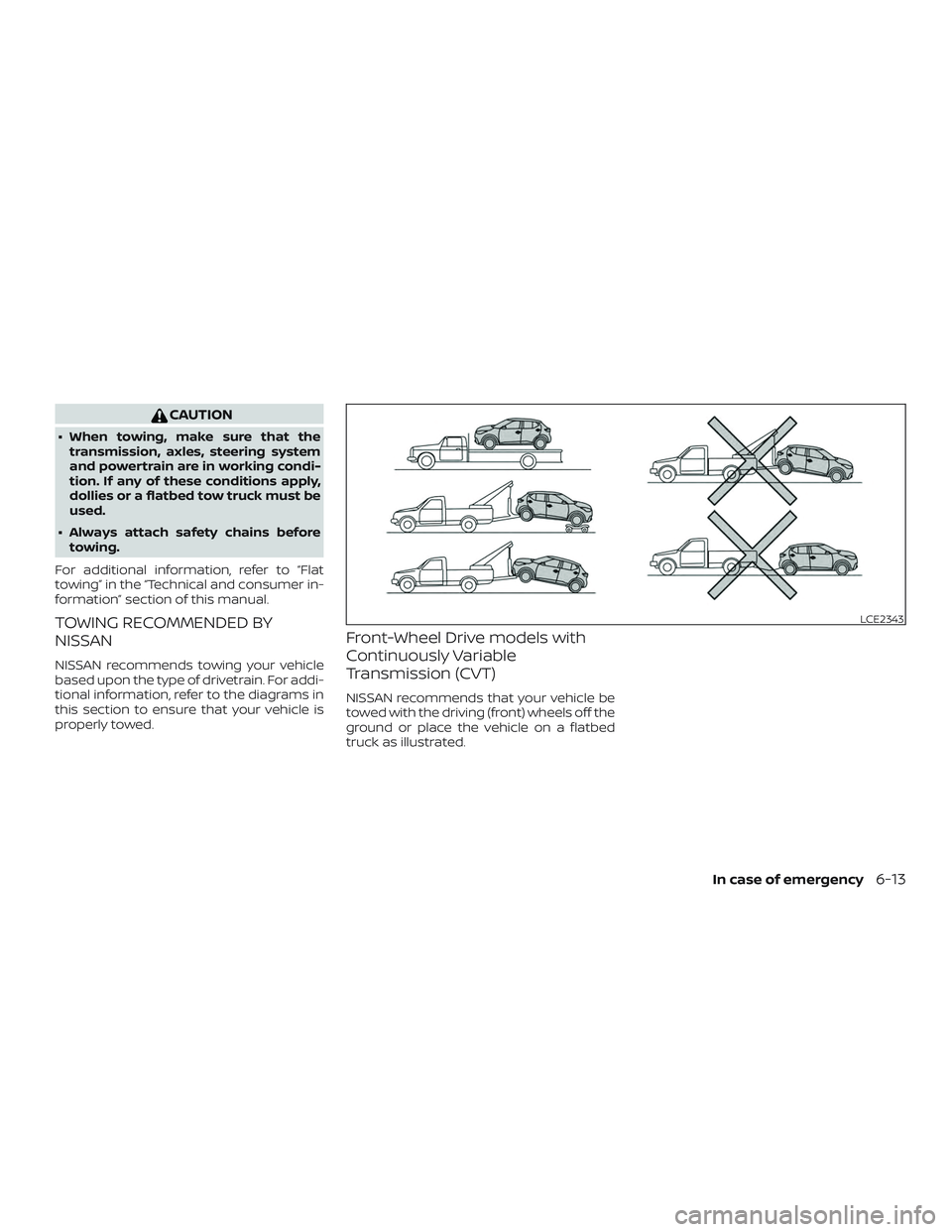
CAUTION
∙ When towing, make sure that thetransmission, axles, steering system
and powertrain are in working condi-
tion. If any of these conditions apply,
dollies or a flatbed tow truck must be
used.
∙ Always attach safety chains before towing.
For additional information, refer to “Flat
towing” in the “Technical and consumer in-
formation” section of this manual.
TOWING RECOMMENDED BY
NISSAN
NISSAN recommends towing your vehicle
based upon the type of drivetrain. For addi-
tional information, refer to the diagrams in
this section to ensure that your vehicle is
properly towed.
Front-Wheel Drive models with
Continuously Variable
Transmission (CVT)
NISSAN recommends that your vehicle be
towed with the driving (front) wheels off the
ground or place the vehicle on a flatbed
truck as illustrated.
LCE2343
In case of emergency6-13
Page 394 of 444
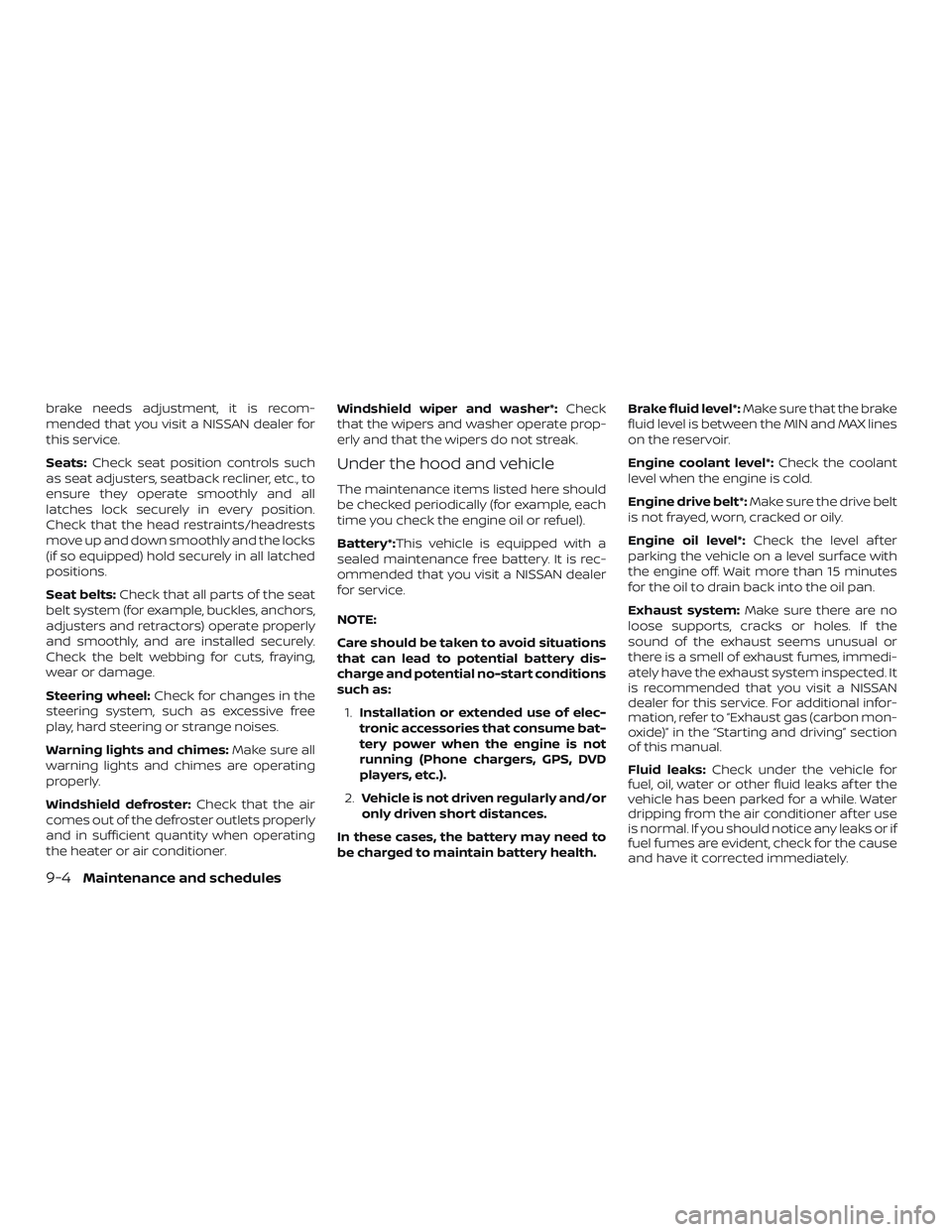
brake needs adjustment, it is recom-
mended that you visit a NISSAN dealer for
this service.
Seats:Check seat position controls such
as seat adjusters, seatback recliner, etc., to
ensure they operate smoothly and all
latches lock securely in every position.
Check that the head restraints/headrests
move up and down smoothly and the locks
(if so equipped) hold securely in all latched
positions.
Seat belts: Check that all parts of the seat
belt system (for example, buckles, anchors,
adjusters and retractors) operate properly
and smoothly, and are installed securely.
Check the belt webbing for cuts, fraying,
wear or damage.
Steering wheel: Check for changes in the
steering system, such as excessive free
play, hard steering or strange noises.
Warning lights and chimes: Make sure all
warning lights and chimes are operating
properly.
Windshield defroster: Check that the air
comes out of the defroster outlets properly
and in sufficient quantity when operating
the heater or air conditioner. Windshield wiper and washer*:
Check
that the wipers and washer operate prop-
erly and that the wipers do not streak.
Under the hood and vehicle
The maintenance items listed here should
be checked periodically (for example, each
time you check the engine oil or refuel).
Battery*:This vehicle is equipped with a
sealed maintenance free battery. It is rec-
ommended that you visit a NISSAN dealer
for service.
NOTE:
Care should be taken to avoid situations
that can lead to potential battery dis-
charge and potential no-start conditions
such as:
1. Installation or extended use of elec-
tronic accessories that consume bat-
tery power when the engine is not
running (Phone chargers, GPS, DVD
players, etc.).
2. Vehicle is not driven regularly and/or
only driven short distances.
In these cases, the battery may need to
be charged to maintain battery health. Brake fluid level*:
Make sure that the brake
fluid level is between the MIN and MAX lines
on the reservoir.
Engine coolant level*: Check the coolant
level when the engine is cold.
Engine drive belt*: Make sure the drive belt
is not frayed, worn, cracked or oily.
Engine oil level*: Check the level af ter
parking the vehicle on a level surface with
the engine off. Wait more than 15 minutes
for the oil to drain back into the oil pan.
Exhaust system: Make sure there are no
loose supports, cracks or holes. If the
sound of the exhaust seems unusual or
there is a smell of exhaust fumes, immedi-
ately have the exhaust system inspected. It
is recommended that you visit a NISSAN
dealer for this service. For additional infor-
mation, refer to “Exhaust gas (carbon mon-
oxide)” in the “Starting and driving” section
of this manual.
Fluid leaks: Check under the vehicle for
fuel, oil, water or other fluid leaks af ter the
vehicle has been parked for a while. Water
dripping from the air conditioner af ter use
is normal. If you should notice any leaks or if
fuel fumes are evident, check for the cause
and have it corrected immediately.
9-4Maintenance and schedules
Page 429 of 444
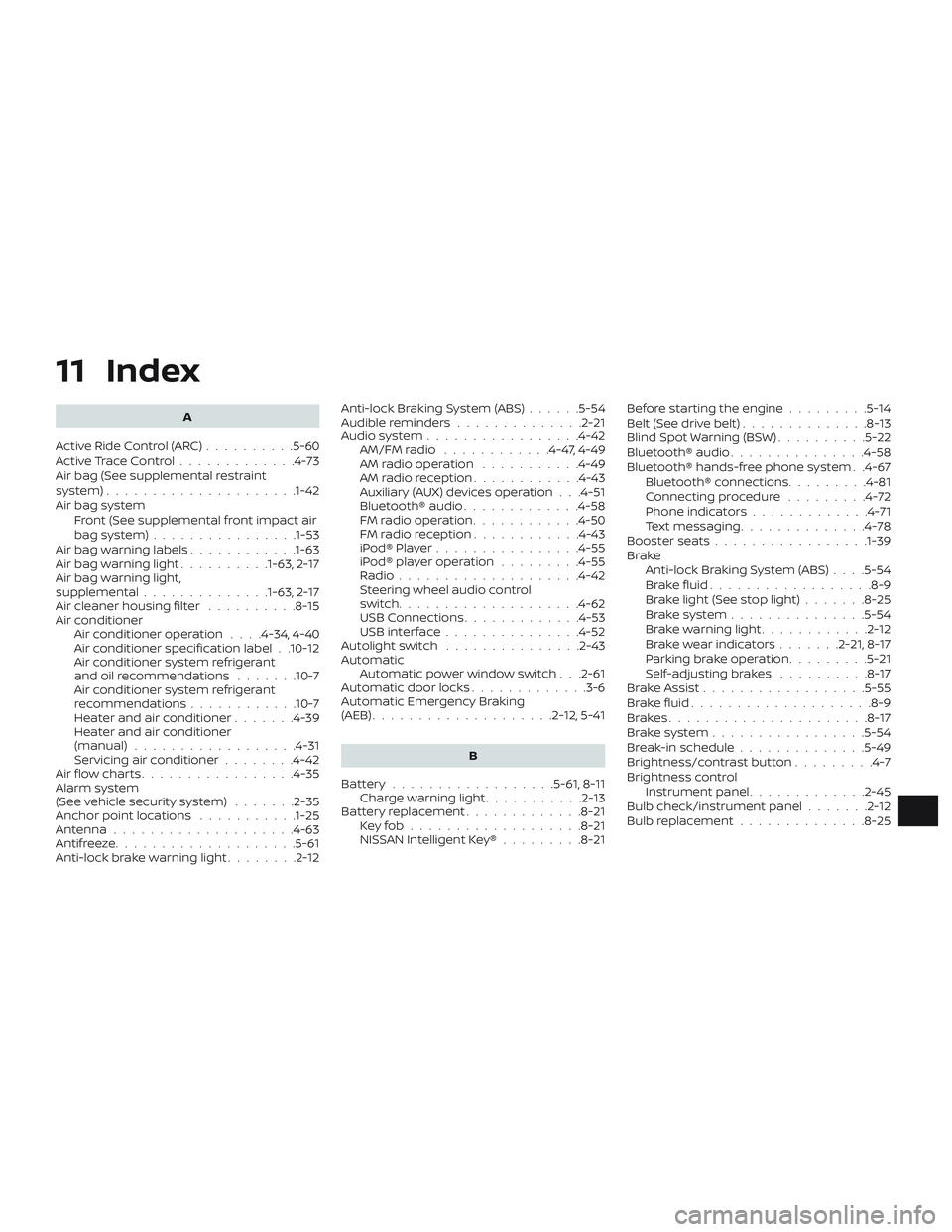
11 Index
A
ActiveRideControl(ARC)..........5-60
ActiveTraceControl.............4-73
Air bag (See supplemental restraint
system) .................... .1-42
Air bag system Front (See supplemental front impact air
bagsystem)............... .1-53
Air bag warning labels ............1-63
Airbagwarninglight..........1-63, 2-17
Air bag warning light,
supplemental ..............1-63, 2-17
Air cleaner housing filter ..........8-15
Air conditioner Air conditioner operation ....4-34,4-40
Air conditioner specification label . .10-12
Air conditioner system refrigerant
and oil recommendations .......10-7
Air conditioner system refrigerant
recommendations ............10-7
Heater and air conditioner .......4-39
Heater and air conditioner
(manual) ..................4-31
Servicing air conditioner ........4-42
Air flow charts .................4-35
Alarm system
(See vehicle security system) .......2-35
Anchor point locations ...........1-25
Antenna ....................4-63
Antifreeze ....................5-61
Anti-lock brake warning light ........2-12Anti-lock Braking System (ABS)
......5-54
Audible reminders ..............2-21
Audiosystem.................4-42 AM/FMradio ............4-47,4-49
AM radio operation ...........4-49
AMradioreception............4-43
Auxiliary (AUX) devices operation . . .4-51
Bluetooth® audio .............4-58
FM radio operation ............4-50
FMradioreception............4-43
iPod®Player................4-55
iPod® player operation .........4-55
Radio ....................4-42
Steering wheel audio control
switch....................4-62
USB Connections .............4-53
USBinterface...............4-52
Autolightswitch ...............2-43
Automatic Automatic power window switch . . .2-61
Automatic door locks .............3-6
Automatic Emergency Braking
(AEB) ....................2-12,5-41
B
Battery..................5-61,8-11 Charge warning light ...........2-13
Battery replacement .............8-21
Keyfob...................8-21
NISSAN Intelligent Key® .........8-21Before starting the engine
.........5-14
Belt(Seedrivebelt)..............8-13
Blind Spot Warning (BSW) ..........5-22
Bluetooth® audio ...............4-58
Bluetooth® hands-free phone system . .4-67 Bluetooth® connections .........4-81
Connecting procedure .........4-72
Phone indicators .............4-71
Text messaging ..............4-78
Booster seats .................1-39
Brake Anti-lock Braking System (ABS) ....5-54
Brakefluid..................8-9
Brakelight(Seestoplight).......8-25
Brakesystem...............5-54
Brakewarninglight............2-12
Brakewearindicators.......2-21,8-17
Parking brake operation .........5-21
Self-adjustingbrakes ..........8-17
Brake Assist ..................5-55
B
rakefluid....................8-9
Brakes......................8-17
Brakesystem.................5-54
Break-in schedule ..............5-49
Brightness/contrast button .........4-7
Brightness control Instrument panel .............2-45
Bulb check/instrument panel .......2-12
Bulb replacement ..............8-25
Page 433 of 444
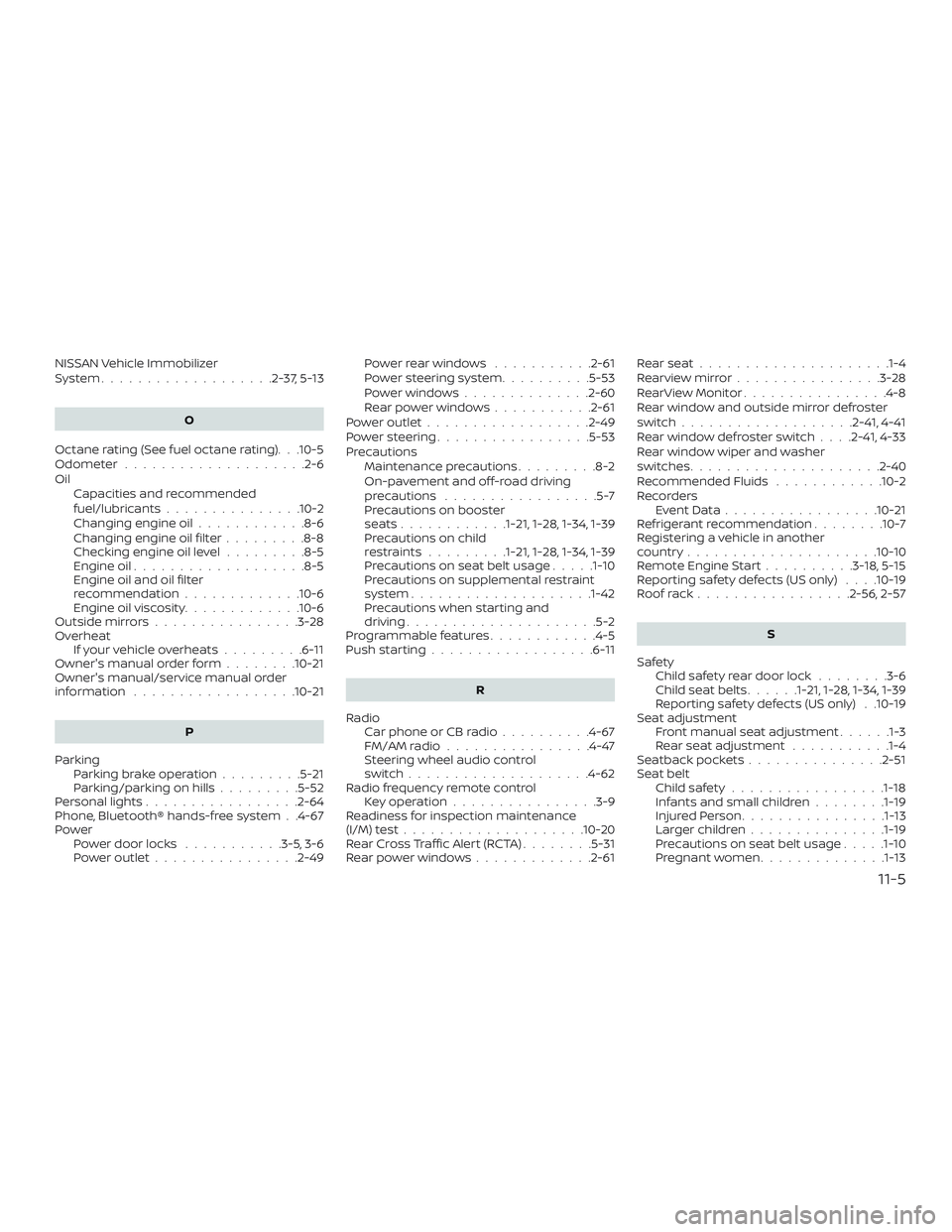
NISSAN Vehicle Immobilizer
System...................2-37,5-13O
Octane rating (See fuel octane rating). . .10-5
Odometer ....................2-6
Oil Capacities and recommended
fuel/lubricants...............10-2
Changing engine oil ............8-6
Changing engine oil filter .........8-8
Checking engine oil level .........8-5
Engine oil ...................8-5
Engine oil and oil filter
recommendation .............10-6
Engine oil viscosity .............10-6
Outsidemirrors................3-28
Overheat Ifyourvehicleoverheats.........6-11
Owner's manual order form ........10-21
Owner's manual/service manual order
information ..................10-21
P
Parking Parking brake operation .........5-21
Parking/parkingonhills.........5-52
Personal lights .................2-64
Phone, Bluetooth® hands-free system . .4-67
Power Power door locks ...........3-5,3-6
Poweroutlet................2-49 Powerrearwindows ...........2-61
Power steering system
..........5-53
Powerwindows..............2-60
Rearpowerwindows...........2-61
Poweroutlet..................2-49
Powersteering.................5-53
Precautions Maintenance precautions .........8-2
On-pavement and off-road driving
precautions .................5-7
Precautions on booster
seats............1-21, 1-28, 1-34, 1-39
Precautions on child
restraints.........1-21, 1-28, 1-34, 1-39
Precautions on seat belt usage .....1-10
Precautions on supplemental restraint
system ................... .1-42
Precautions when starting and
driving.....................5-2
Programmable features ............4-5
Push starting ..................6-11
R
Radio Car phone or CB radio ..........4-67
FM/AMradio................4-47
Steering wheel audio control
switch....................4-62
Radio frequency remote control Key operation ................3-9
Readiness for inspection maintenance
(I/M) test ....................10-20
RearCrossTrafficAlert(RCTA)........5-31
Rearpowerwindows.............2-61 Rearseat.....................1-4
Rearviewmirror................3-28
RearViewMonitor................4-8
Rear window and outside mirror defroster
switch...................2-41,4-41
Rear window defroster switch . . . .2-41, 4-33
Rear window wiper and washer
switches
.....................2-40
Recommended Fluids ............10-2
Recorders EventData.................10-21
Refrigerant recommendation ........10-7
Registering a vehicle in another
country .....................10-10
Remote Engine Start ..........3-18,5-15
Reporting safety defects (US only) . . . .10-19
Roofrack.................2-56,2-57
S
Safety Child safety rear door lock ........3-6
Childseatbelts......1-21, 1-28, 1-34, 1-39
Reporting safety defects (US only) . .10-19
Seat adjustment Front manual seat adjustment ......1-3
Rear seat adjustment ...........1-4
Seatback pockets ...............2-51
Seat belt C
hildsafety................ .1-18
Infants and small children ........1-19
InjuredPerson............... .1-13
Largerchildren.............. .1-19
Precautionsonseatbeltusage.....1-10
Pregnant women ..............1-13
11-5
Page 434 of 444
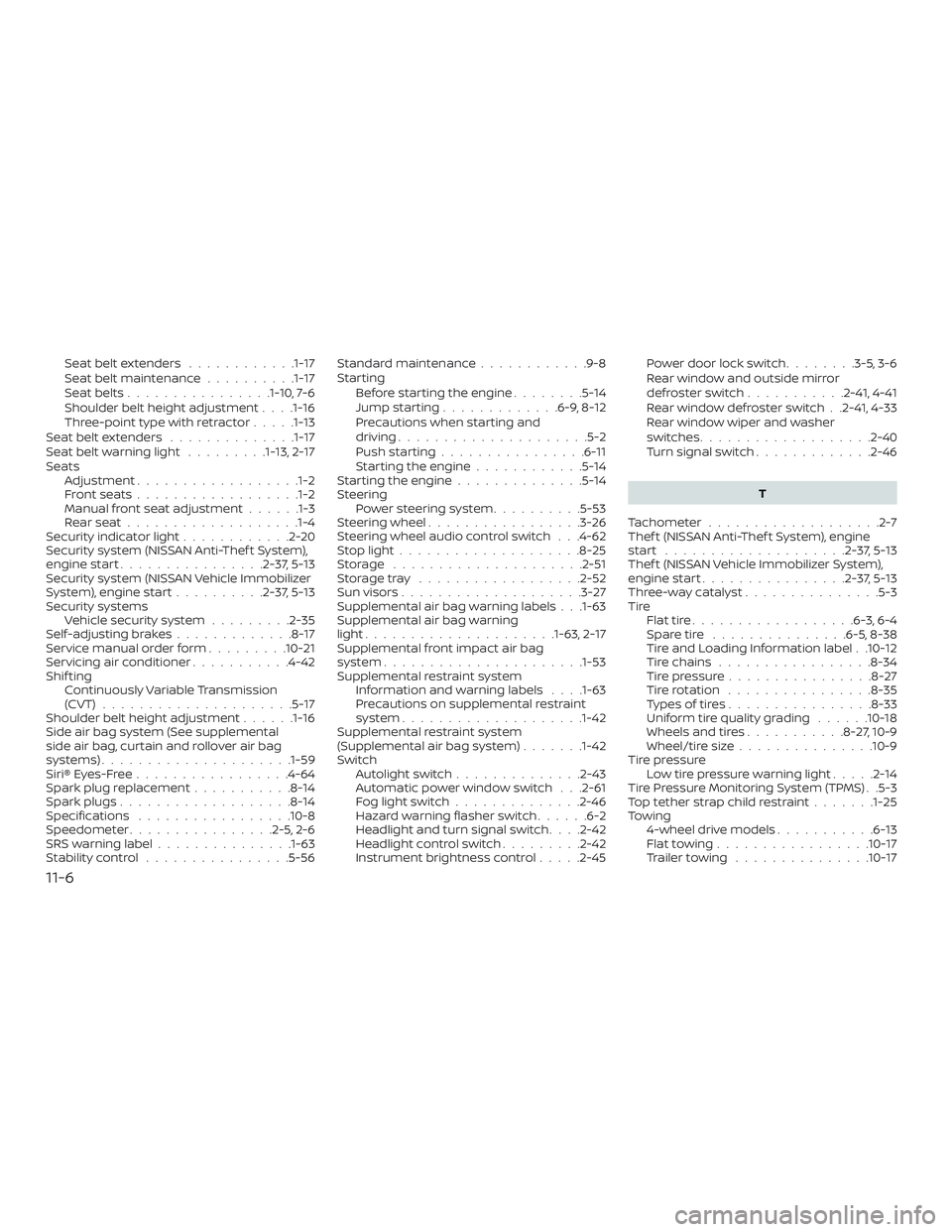
Seat belt extenders............1-17
Seat belt maintenance ..........1-17
Seatbelts................1-10, 7-6
Shoulder belt height adjustment . . . .1-16
Three-pointtypewithretractor.....1-13
Seat belt extenders ..............1-17
Seatbeltwarninglight .........1-13, 2-17
Seats Adjustment ..................1-2
Frontseats..................1-2
Manual front seat adjustment ......1-3
Rearseat.................. .1-4
Security indicator light ............2-20
Security system (NISSAN Anti-Thef t System),
engine start ................2-37,5-13
Security system (NISSAN Vehicle Immobilizer
System), engine start ..........2-37,5-13
Security systems Vehicle security system .........2-35
Self-adjustingbrakes.............8-17
Service manual order form .........10-21
Servicing air conditioner ...........4-42
Shif ting Continuously Variable Transmission
(CVT) .....................5-17
Shoulder belt height adjustment ......1-16
Side air bag system (See supplemental
side air bag, curtain and rollover air bag
systems) .................... .1-59
Siri® Eyes-Free .................4-64
Spark plug replacement ...........8-14
Spark plugs ...................8-14
Specifications .................10-8
Speedometer ................2-5,2-6
SRS warning label ...............1-63
Stability control ................5-56 Standard maintenance
............9-8
Starting Before starting the engine ........5-14
Jumpstarting.............6-9,8-12
Precautions when starting and
driving.....................5-2
Push starting ................6-11
Starting the engine ............5-14
Starting the engine ..............5-14
Steering Powersteeringsystem..........5-53
Steering wheel .................3-26
Steering wheel audio control switch . . .4-62
Stoplight....................8-25
Storage .....................2-51
Storagetray ..................2-52
Sunvisors....................3-27
Supplemental air bag warning labels . . .1-63
Supplemental air bag warning
light.................... .1-63, 2-17
Supplemental front impact air bag
system ..................... .1-53
Supplemental restraint system Information and warning labels . . . .1-63
Precautions on supplemental restraint
system ................... .1-42
Supplemental restraint system
(Supplemental air bag system) .......1-42
Switch Autolightswitch..............2-43
Automatic power window switch . . .2-61
Foglightswitch..............2-46
Hazard warning flasher switch ......6-2
Headlight and turn signal switch ....2-42
Headlightcontrolswitch.........2-42
Instrument brightness control .....2-45Power door lock switch
........3-5 , 3-6
Rear window and outside mirror
defrosterswitch...........2-41,4-41
Rear window defroster switch . .2-41, 4-33
Rear window wiper and washer
switches ...................2-40
Turn signal switch .............2-46
T
Tachometer ...................2-7
Thef t (NISSAN Anti-Thef t System), engine
start ....................2-37,5-13
Thef t (NISSAN Vehicle Immobilizer System),
engine start ................2-37,5-13
Three-waycatalyst...............5-3
Tire Flattire..................6-3,6-4
Spare tire ...............6-5,8-38
Tire and Loading Information label . .10-12
Tire chains .................8-34
Tire pressure ................8-27
Tirerotation ................8-35
Types of tires ................8-33
Uniform tire quality grading ......10-18
Wheels and tires ...........8-27,10-9
Wheel/tire size ...............10-9
Tire pressure Low tire pressure warning light .....2-14
Tire Pressure Monitoring System (TPMS) . .5-3
Toptetherstrapchildrestraint.......1-25
Towing 4-wheel drive models ...........6-13
Flattowing.................10-17
Trailertowing ...............10-17
11-6